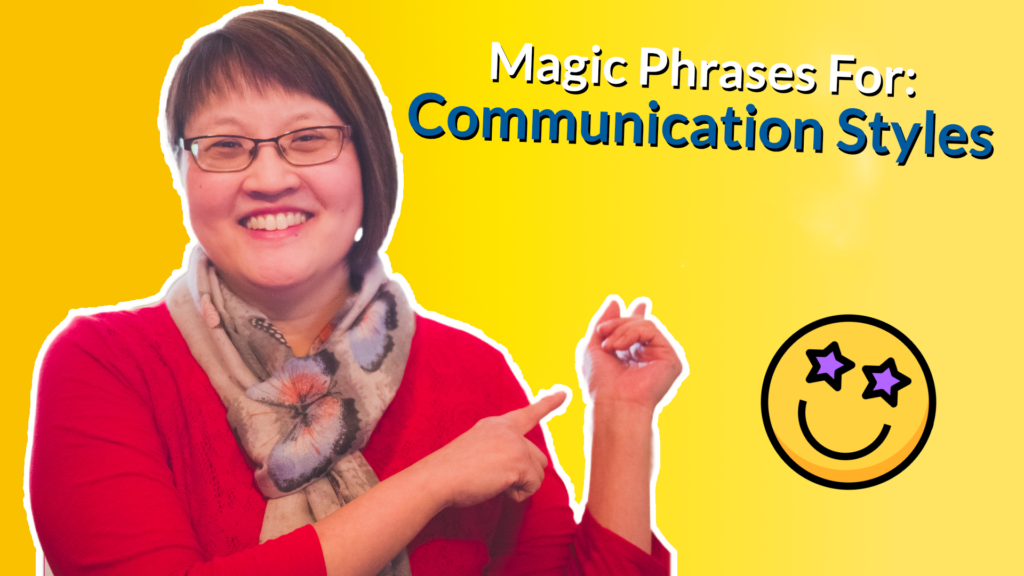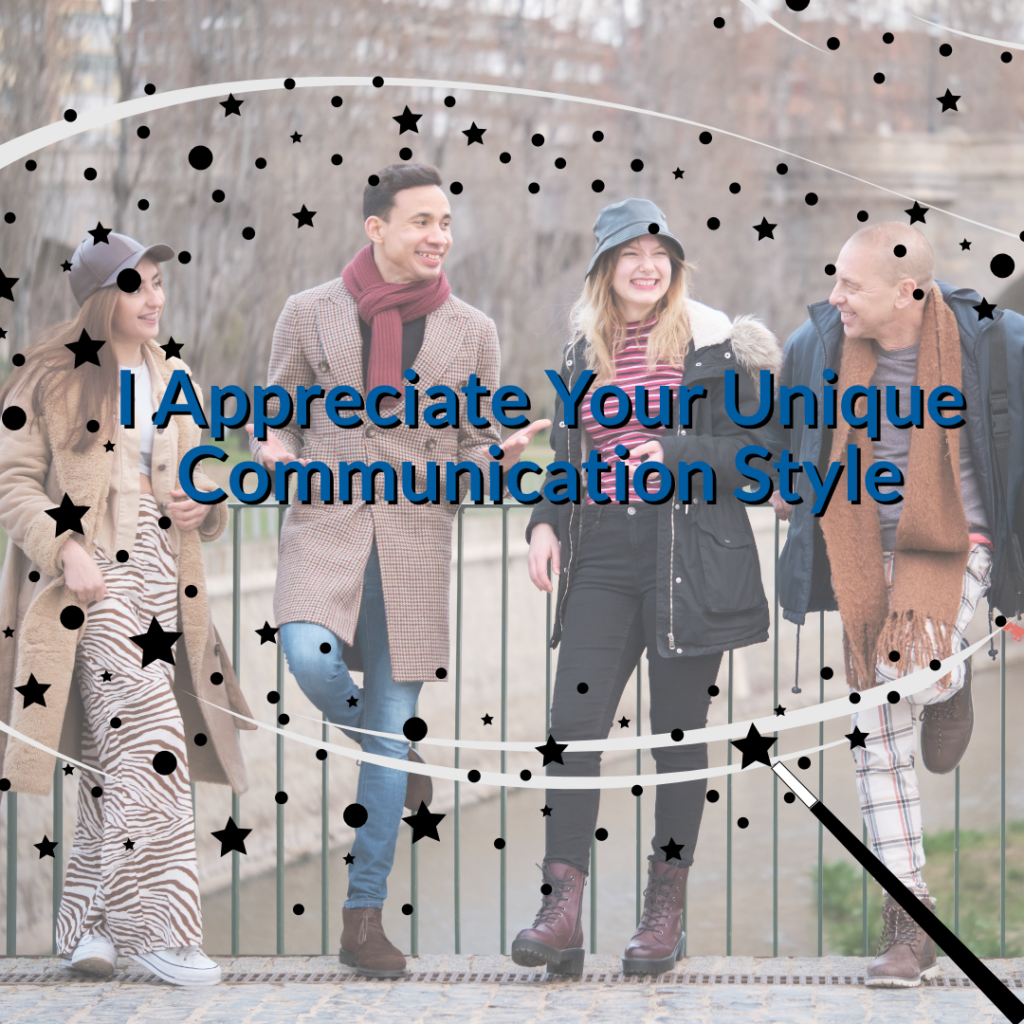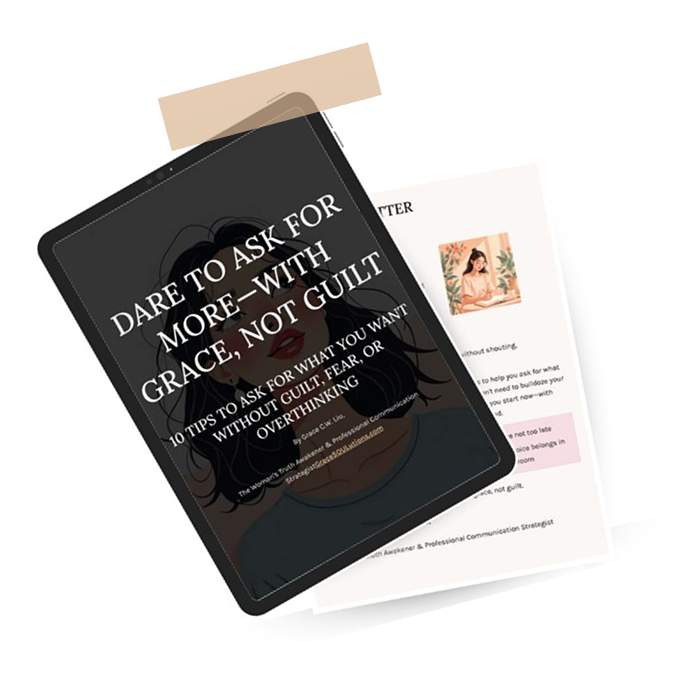If you’re a sensitive, introverted, conflict phobic person who is also a people pleaser, and we’d love to be able to openly and confidently communicate your thoughts, feelings and desires without the fear of arguments or criticisms, so that you can have a happy and harmonious relationship with your partner. Stay tuned for fun and valuable information.
Hi, I’m Grace, and welcome to the communication warrior game, or what I like to call the communicate game.
Now, if you have missed the other seven videos, in this video series, that’s okay, stay here for now. And you can always catch up with those videos later on.
So in today’s communicate video series, we’re going to be talking about awareness, awareness of your words, awareness of your tone of voice, awareness of your facial expression, body language, hand gestures, and your communication. Because how many of you are truly aware of how you say things, or what you say, in your communication, because I like to present this as an analogy, think of an artist. And in this case, a painter who paints a picture, right, the painter is painting the picture. But as the painter is painting his or her picture, he or she is stepping back, taking a look at what he or she has painted. So far, the painter might add a few more colors, or take away a few colors, or make it a little bit more subtle, because the painter is creating a feeling that he or she wants the viewer that’s viewing the painting, to have to experience and so you as the communicator, you are also creating a feeling and an image of what you want your listener to have when you’re communicating with him. And so you as the communicator, you’re also creating an image or a feeling that you want your listener to have as you are communicating to him or her. So, the painter has tools, paint brushes, paints, Canvas or paper to paint on. And you as your communicator, your tools are your words, your tone of voice, your body language, facial expressions, and perhaps even your hands if you’d like to talk with your hands. And then for the people who are deaf, they communicate using your hands through sign language. So awareness then becomes that you are aware of what you are saying and how you’re saying things along with using all your other tools to create that image and the feeling that you want your listener to have.
So let’s see how the four communication characters the communicators show their awareness and their communication.
So our first communication character communicator is stance dance is our confident communicator. So let’s welcome stance. So, stance is going to be aware of his or her words and actions, you know body language as well as facial expressions, whatever it may be, because scamps is confident. So stance wants to demonstrate the confidence by showing that he or she is aware and because scan’s is aware of his or her words and actions and how it can impact a person’s feeling. When Stan’s communicates with his or her partner, they’re going to take into account that they want to create a certain feeling that they want their partners to have stands and is also aware of the feeling that the partner also is portraying. And so Scam School very clearly will skate why you know your to the partner you’re making me feel this way or your words makes me feel a certain way because stance understands how words can impact a person’s feeling and what words can also create a certain feeling so that is stance
Alright, let’s welcome our next communication character our next communicator will be brash All right Hello brash this is our arrogant communicator and brash isn’t so much concerned about his or her actions or the words. So in some ways, brash may or may not be completely aware of his or her actions or the words they’re saying or how it might impact a person. You know, brash is just concerned about just getting the message out, right. And making sure that whatever needs to be said is said, however, brash may not be completely aware that what he says or what what he or she says, or how they say it might impact the partners feelings, or who they’re speaking to, how it might impact the feeling of the listener, so brash might be a very much of a motivator, wants to motivate the person, or his or her partner, however, because of the words, or the tone of voice or the action of it, and might be off putting, right because it might come off as too aggressive, or too much of, you know, fire or, or what have you that it just doesn’t make the person feel comfortable and brash may or may not be aware of this, right? Because brash just wants to get the message across, like, you can do it, you can get it done, you know, what have you. But the other person that’s listening is kind of like going, Well, I appreciate you letting them let me know, yes, I can do this. But it’s too aggressive for me, then it’s, you know, it almost feels like you’re yelling at me, and I don’t know about you, but I don’t like to be yelled at. Right. So to some people, they don’t mind. They like that, kind of like drill sergeant that yeah, you know, to help them to move and help them to stay on track. For some people, it can be like, you know, you’re yelling at me, I don’t want to be yelled at, I don’t know, you know, do you have to shout at me, I mean, I’m responsible, I do get things done, but you yelling me or I SCORM you making me feel like you’re yelling at me, is not helping me. I don’t feel supported that way. Right. So, you know, again, brash may or may not be aware that that action is creating a certain feeling in the person. Again, they’re just wanting to, you know, their, their intention is to motivate the person, but they might not be aware, like how they’re motivating the person is maybe actually doing the opposite. So that that’s brush, right. So, again, a brush may or may not be aware of how his or her action is actually impacting the person’s feeling.
All right, and so our next communicator is gray, and gray as our timet. Communicator, here is gray. Now, gray is very much a person that wants to avoid conflict, right? Hannah wants to hide in the background a bit, you know. So gray might be one that’s a little bit too overly sensitive of the actions. And other words, gray might be overly hypersensitive, or almost hyper aware of his or her words and actions, that they feel like, every word or every action they do, might create a conflict with a person they’re speaking with, they’re afraid that whatever they say, or a word that is spoken, or an action that is given, you know, a body language or facial expression might be picked up wrong by the other person, that now there’s going to be a conflict because of it. So gray might be like really overly, like a say maybe hyper aware of the words and actions to the point where then it’s almost like great, feel stuck, right? And doesn’t want to say anything or do any thing like me, you know, really aware of the body language. So they might just kind of hold themselves tight and try to keep a neutral face or you know, try to keep their voice as calm as possible, because they feel it maybe in a lot of ways that anything they say or do keep might be picked up wrong. And then therefore creating that conflict that they are trying to avoid. And so a lot of cases gray or timid communicator might be more of the type of person to hold back. Right because, again,
they might feel like the words and the action Some might be picked up wrong, that would create a conflict. So what gray needs to realize is that some times, yes, it can be the words and the actions. However many, many situations, they are not responsible. Right? They’re not responsible how the person is going to react, the sky is blue, the person might react positively like, Hey, son. And for some people, the person might react very badly, like, yeah, it’s blue, and the sun is blinding my eyes, and it’s super hot, and what have you, right? So gray could just simply say, hey, it’s a nice day, the sky is blue. And the other person can be set off by it. Right? Either in a positive way, saying, yeah, the sky is blue, nice day, you know, day to go out where the other person might react very badly and say, yeah, the sky is blue, the sun is blinding my eyes, and it’s super hot outside, yay. Yeah, we can’t do anything in the yard because it’s too hot, or what have you. So what gray needs to realize is communicate in a way that is comfortable for him or her use the words that resonate, and also try to use words that resonate with the person they’re speaking with. And as the person reacts badly, just realize it’s not on gray, it’s actually on the other person. So what is difficult here, it’s about responsibility for our relationships. Yes, we are responsible for our relationships, we are responsible for what we say and how we say things, right? Because we don’t want to be too aggressive. But sometimes we might need to be what we have, perhaps a challenge of is knowing when we are no longer responsible, we’re not responsible for the person’s reaction, we might do things and say things very clearly and in a calm voice, but the other person might pick up wrong. And this is where great my struggle, because in some ways, we’re not responsible for the person being happy or not, we can say all the right things, and do all the right actions. However, that person might not be happy with us, they might still complain. And they might say, Well, you didn’t do this, and you should have done this. And so in some aspect, we can only do the best that we can, and make sure that we’re saying things and doing things to the best of our ability, but how the person reacts that might not be so much on our part. I hope that explains a little bit better. So that’s where some of that communication part. Some of the times it’s kind of difficult is like yes, we’re responsible for our relationship, but how much responsibility do we take and how much do we say, you know, what, this is not part of my responsibility that is on the other person. And I think sometimes it’s that fine line that makes it perhaps difficult for gray to decide or to distinguish of, you know, what I am responsible for that I am able to speak out and what is not part of my responsibility and that is on the other person.
We have bled our Shapeshifter communicator blend. So, blend is going to be able to sense the room since the person sense the situation and then decide how he or she is going to be either going to be like stance, the confident communicator or perhaps brash, the arrogant communicator or perhaps like gray, the timid communicator. So, you know, because blend can sense the room sense the person’s sense of situation, blind is just going to choose and decide, which perhaps the character with a communicator will be better for that situation. Again, there’s no right or wrong way to communicate, or there’s no good or bad communication characters or communicator. You know, each has its strengths as well as its weaknesses. And bland is going to try for the most part to grab on to all the communicators in a positive way to be able to communicate and show awareness of the actions. So in some situations, it might be necessary to grab the positive aspect of brash and in communicating the awareness Right, if the person has a cutting of not paying attention or not being aware of him or herself, bland might just say, You know what, then in this case, I need to be brash, you know, in a positive way. And then perhaps in some situations, blend my say I am, I’m gonna use gray gray strength, in awareness when communicating, and then also perhaps in some situations stance, right. So blend is going to, in most cases, use the positive characters, or the positive aspects of the communication characters. And using the ability of the, of the awareness of each of the characters or whichever characters blend chooses to use, but in a positive way of communicating the awareness of being aware of how he or she communicates as well.
And then, of course, you as the communication character. And this is you being confident, right, and being aware of what you say, and how you communicate to your partner to create that feeling. And if you don’t sometimes need to be like, brash, you’re aware of that. You are also aware when sometimes you might need to be like stance or gray. But you being aware of that, in itself makes you the communication warrior, because you know, then, you know, this is how I need to be, or this is what I this is a character I am going to be or choosing to be, and communicating because you are now aware of that. You’re now creating that image and the feeling that you want your listener to have your partner to have when you’re communicating with your partner. And if you don’t feel like a communication warrior yet.
That’s okay. I invite you to visit my website, Grace solutions.com. That’s GRACESOULU t i o n s.com. To see how you can book a free communication breakthrough session with me, where we will discover five obstacles and one action step that you can take that will move you forward to becoming a communication warrior. And in the next video series, we’re going to be talking about tone of voice. So we’ll see how the four communication characters the four communication communicators deal with tone of voice, so stay tuned for that. Thank you for being here. I look forward to seeing you here again next time.
Now go and have fun communicating!




